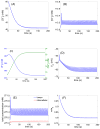Efficiency of primary saliva secretion: an analysis of parameter dependence in dynamic single-cell and acinus models, with application to aquaporin knockout studies
- PMID: 22258315
- PMCID: PMC3364221
- DOI: 10.1007/s00232-011-9413-3
Efficiency of primary saliva secretion: an analysis of parameter dependence in dynamic single-cell and acinus models, with application to aquaporin knockout studies
Abstract
Secretion from the salivary glands is driven by osmosis following the establishment of osmotic gradients between the lumen, the cell and the interstitium by active ion transport. We consider a dynamic model of osmotically driven primary saliva secretion and use singular perturbation approaches and scaling assumptions to reduce the model. Our analysis shows that isosmotic secretion is the most efficient secretion regime and that this holds for single isolated cells and for multiple cells assembled into an acinus. For typical parameter variations, we rule out any significant synergistic effect on total water secretion of an acinar arrangement of cells about a single shared lumen. Conditions for the attainment of isosmotic secretion are considered, and we derive an expression for how the concentration gradient between the interstitium and the lumen scales with water- and chloride-transport parameters. Aquaporin knockout studies are interpreted in the context of our analysis and further investigated using simulations of transport efficiency with different membrane water permeabilities. We conclude that recent claims that aquaporin knockout studies can be interpreted as evidence against a simple osmotic mechanism are not supported by our work. Many of the results that we obtain are independent of specific transporter details, and our analysis can be easily extended to apply to models that use other proposed ionic mechanisms of saliva secretion.
Figures









Similar articles
-
New saliva secretion model based on the expression of Na+-K+ pump and K+ channels in the apical membrane of parotid acinar cells.Pflugers Arch. 2018 Apr;470(4):613-621. doi: 10.1007/s00424-018-2109-0. Epub 2018 Jan 17. Pflugers Arch. 2018. PMID: 29344775
-
A Mathematical Model Supports a Key Role for Ae4 (Slc4a9) in Salivary Gland Secretion.Bull Math Biol. 2018 Feb;80(2):255-282. doi: 10.1007/s11538-017-0370-6. Epub 2017 Dec 5. Bull Math Biol. 2018. PMID: 29209914 Free PMC article.
-
A Multicellular Model of Primary Saliva Secretion in the Parotid Gland.Bull Math Biol. 2020 Mar 11;82(3):38. doi: 10.1007/s11538-020-00712-3. Bull Math Biol. 2020. PMID: 32162119
-
Role of water channels in fluid transport studied by phenotype analysis of aquaporin knockout mice.Exp Physiol. 2000 Mar;85 Spec No:233S-241S. doi: 10.1111/j.1469-445x.2000.tb00028.x. Exp Physiol. 2000. PMID: 10795927 Review.
-
Calcium signaling defects underlying salivary gland dysfunction.Biochim Biophys Acta Mol Cell Res. 2018 Nov;1865(11 Pt B):1771-1777. doi: 10.1016/j.bbamcr.2018.07.002. Epub 2018 Jul 10. Biochim Biophys Acta Mol Cell Res. 2018. PMID: 30006140 Review.
Cited by
-
Effects of polyphenols in non-centrifugal cane sugar on saliva secretion: in vitro and in vivo experiments and a randomized controlled trial.J Clin Biochem Nutr. 2023 Mar;72(2):171-182. doi: 10.3164/jcbn.22-114. Epub 2022 Dec 28. J Clin Biochem Nutr. 2023. PMID: 36936876 Free PMC article.
-
Reply to response to 'What do aquaporin knockout studies tell us about fluid transport in epithelia?' Maclaren OJ, Sneyd J, Crampin EJ (2013) J Membr Biol 246:297-305.J Membr Biol. 2014 Mar;247(3):289-90. doi: 10.1007/s00232-013-9628-6. Epub 2014 Jan 9. J Membr Biol. 2014. PMID: 24402243 No abstract available.
-
Aquaporins in Salivary Glands: From Basic Research to Clinical Applications.Int J Mol Sci. 2016 Jan 27;17(2):166. doi: 10.3390/ijms17020166. Int J Mol Sci. 2016. PMID: 26828482 Free PMC article. Review.
-
Computational modeling of epithelial fluid and ion transport in the parotid duct after transfection of human aquaporin-1.Am J Physiol Gastrointest Liver Physiol. 2017 Feb 1;312(2):G153-G163. doi: 10.1152/ajpgi.00374.2016. Epub 2016 Dec 8. Am J Physiol Gastrointest Liver Physiol. 2017. PMID: 27932503 Free PMC article.
-
A quantitative analysis of electrolyte exchange in the salivary duct.Am J Physiol Gastrointest Liver Physiol. 2012 Nov 15;303(10):G1153-63. doi: 10.1152/ajpgi.00364.2011. Epub 2012 Aug 16. Am J Physiol Gastrointest Liver Physiol. 2012. PMID: 22899825 Free PMC article.
References
-
- Benjamin BA, Johnson EA. A quantitative description of the Na-K-2Cl cotransporter and its conformity to experimental data. Am J Physiol. 1997;273:F473–482. - PubMed
-
- Cook DI, Young JA. Effect of K+ channels in the apical plasma membrane on epithelial secretion based on secondary active Cl- transport. J Membr Biol. 1989;110:139–146. - PubMed
-
- Cook DI, Young JA. Comprehensive Physiology. John Wiley & Sons, Inc; 2010. Fluid and electrolyte secretion by salivary glands.
Publication types
MeSH terms
Substances
Grants and funding
LinkOut - more resources
Full Text Sources
Other Literature Sources
Miscellaneous

